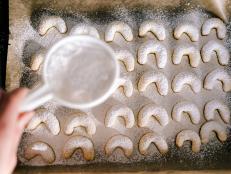How to Know When Your Sourdough Starter Is Ready
Have a cup of water on hand.

Get a Premium Subscription to the Food Network Kitchen App
Download Food Network Kitchen to sign up and get access to live and on-demand cooking classes, in-app grocery ordering, meal planning, an organized place to save all your recipes and much more.
By Erin Hartigan for Food Network Kitchen
Making sourdough bread is a substantial investment of time and work, not to mention flour.
If you're going all-in on baking sourdough, you'll want to be sure that you don't misstep, especially with that all-important sourdough starter. Here's how to be sure that your sourdough starter is ready — get our full how-to on how to make starter here.
Use Your Senses
A few days into feeding your starter, it should be strong enough to bake a loaf. To know that you have an active starter, look to see how it's grown — as you've fed the starter, it should have doubled in volume. It should also look very bubbly and slightly foamy at the surface.
The scent is as important as the look. Your starter should have a strong, but pleasant acidic aroma — this will yield that tangy flavor.
One popular way to know that your sourdough starer is ready is to try floating a bit of it in water. Fill a glass bowl or cup with room-temperature water, and drop a small scoop (a teaspoon or less) of the starter into the water. If it floats, it's ready to use. If it sinks, your starter will need more time to develop, either with another feeding or simply more time to sit and develop air bubbles.
If you don’t feel the starter is ready, continue feeding in 12-hour increments for another day or two.
Keep It Going
Sourdough starters are best kept up by regularly using them to bake with — you can also share them with other aspiring bakers. If you are baking about once a week with your starter, you can cut down the feedings to once or twice a week by storing the starter in the refrigerator, always using a container with plenty of room. To prep your starter for cold storage, give it a regular feeding then let it ripen for about 8 hours, until you see a good amount of activity, then move it to the refrigerator. Check it every so often, ideally every other day. It should smell pleasantly sour and have visible bubbles on top. You should NOT see watery liquid on the surface or smell alcohol.
Depending on the strength of your starter you can go between 2 days and 1 week between feedings. Feed as normal, leaving the starter out at warm room temperature to ripen for 6-8 hours before refrigerating.
Related Links:




























.jpg.rend.hgtvcom.231.174.suffix/1681323015319.jpeg)




